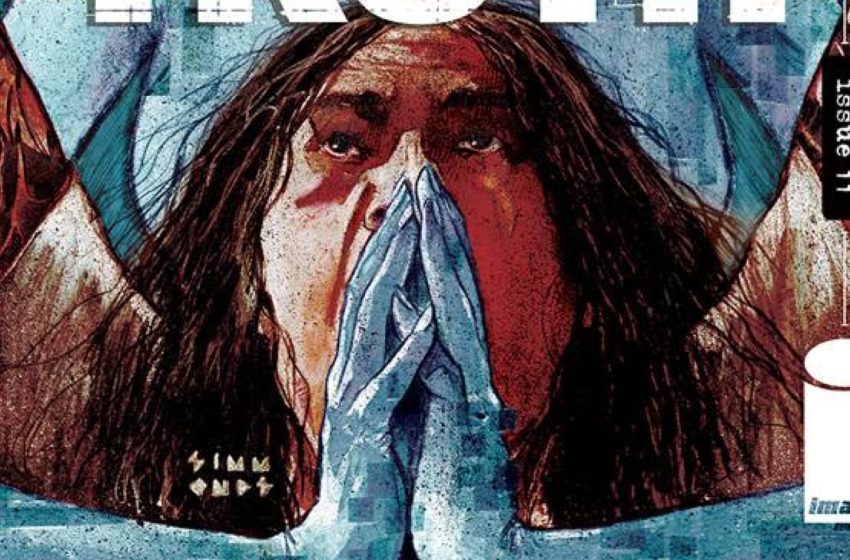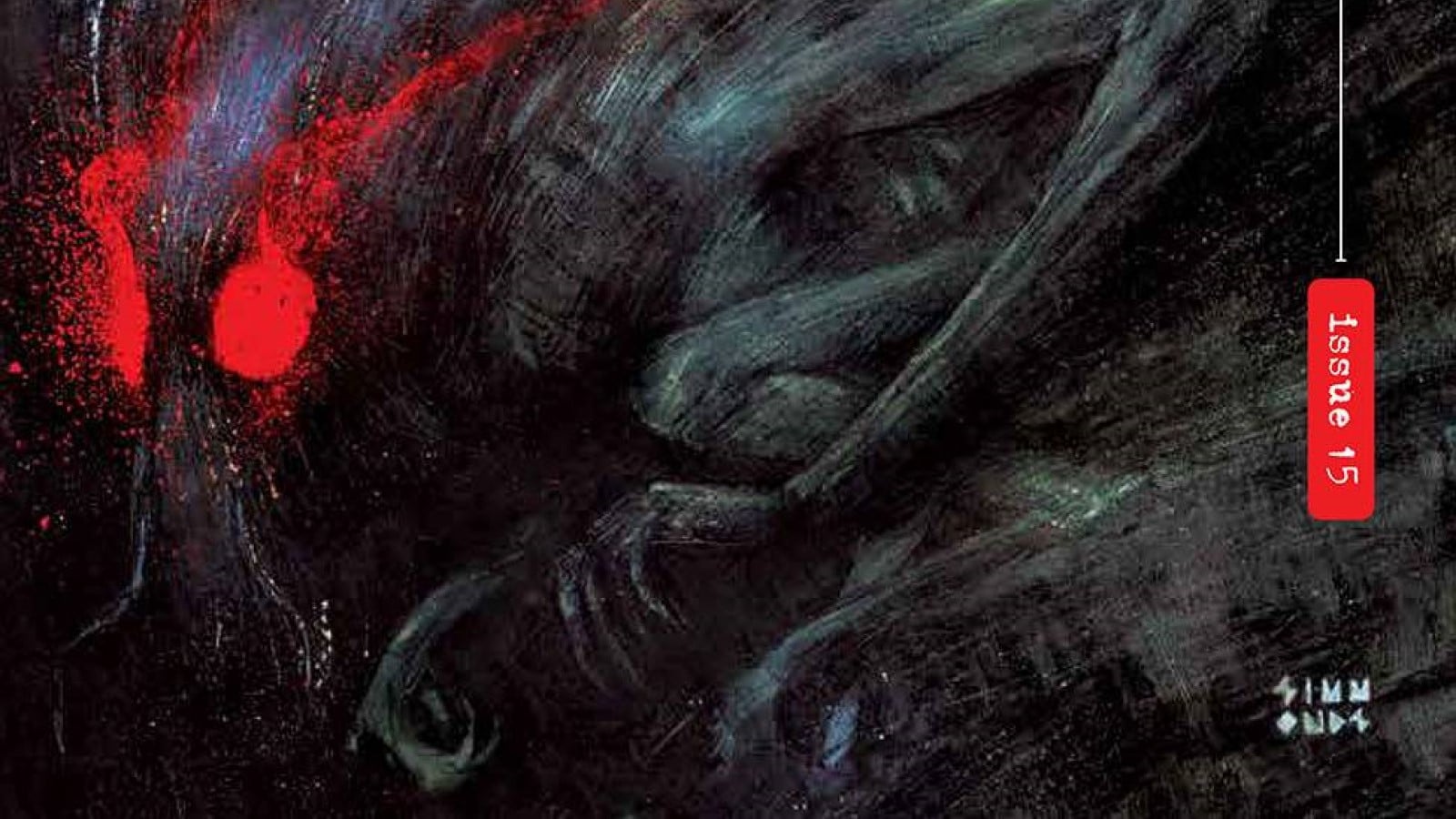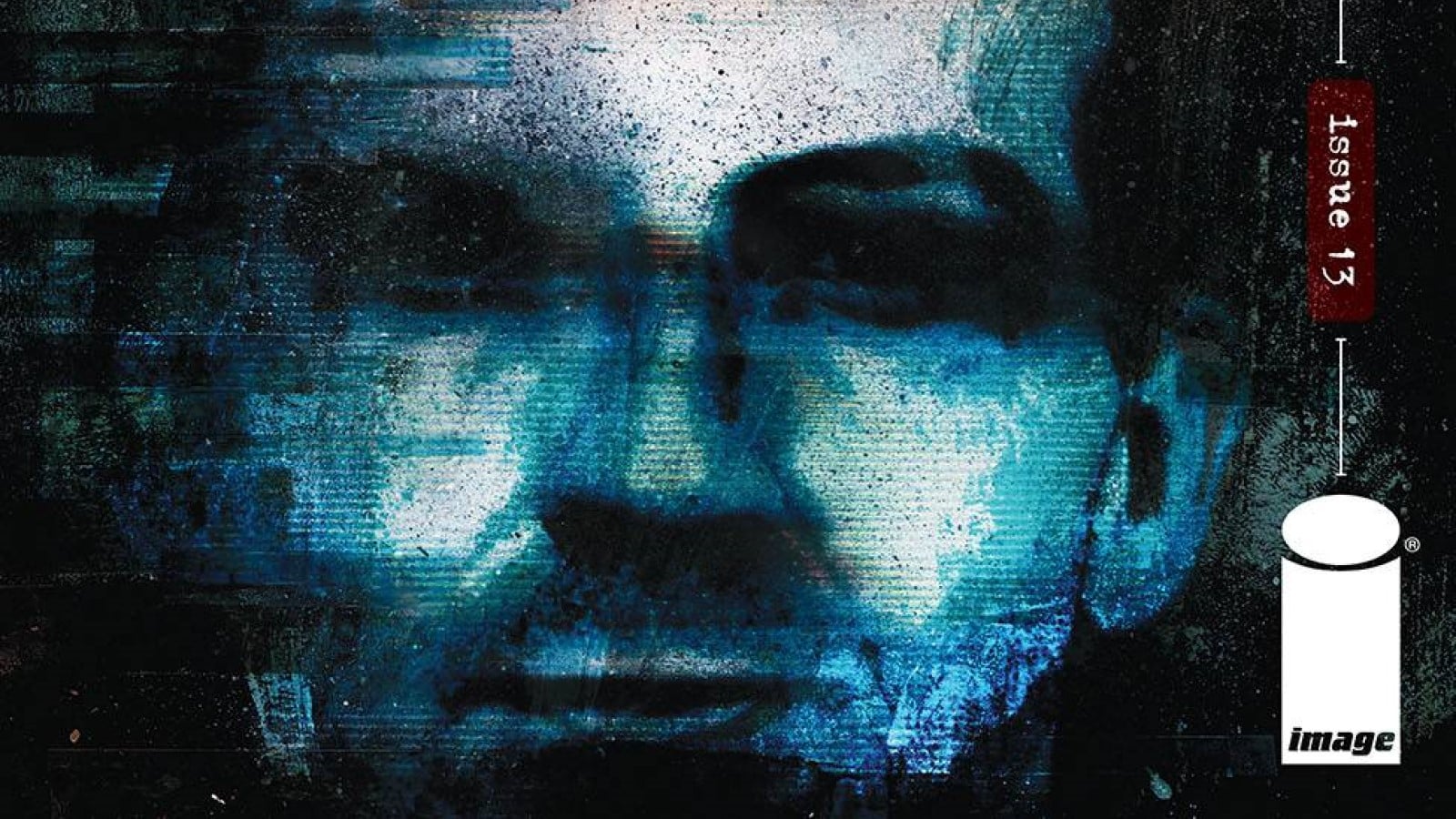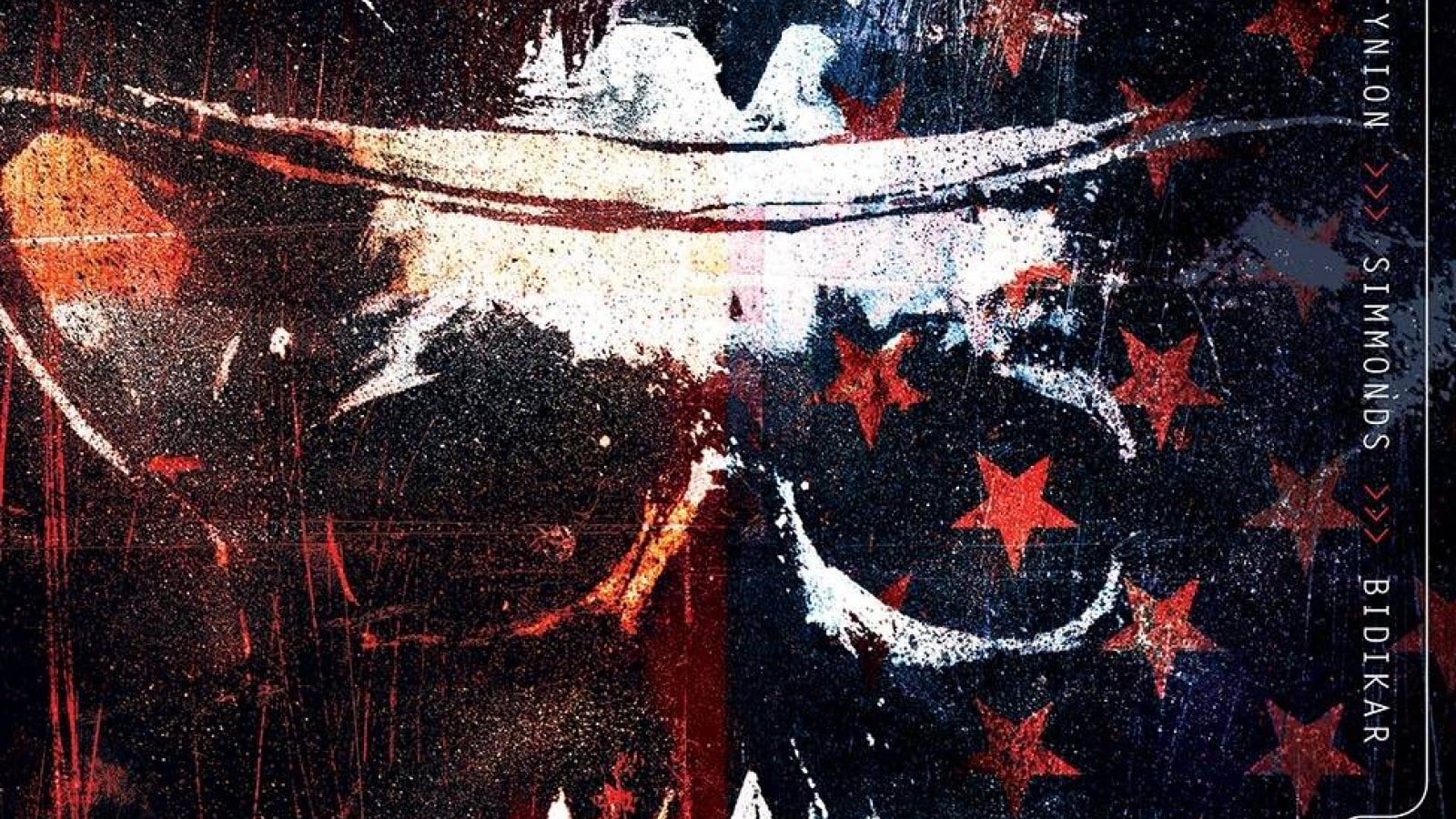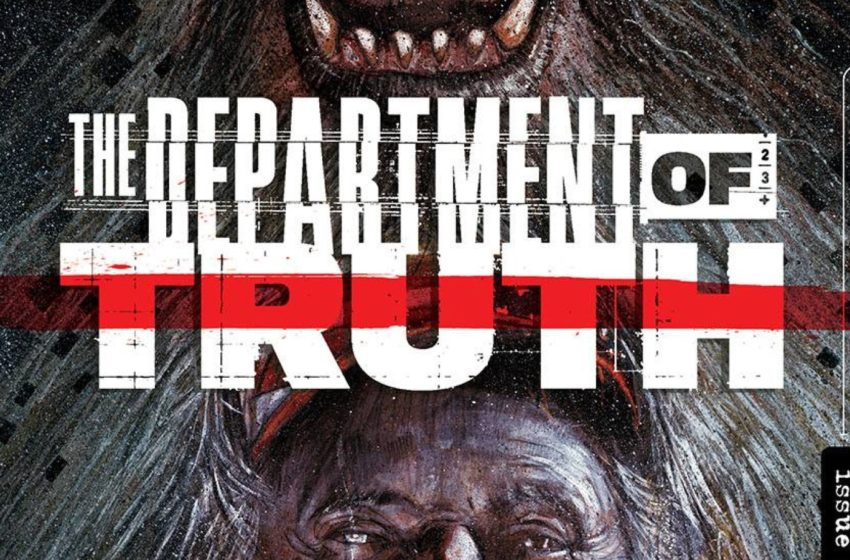Department of Truth agents Turner, Harrison and [insert Field Ranger Darla’s last name here] trek into the woods to kill a Bigfoot and stop one man from spreading his views of the world. What they find is something bigger than any cryptid imaginable in Department of Truth #11, written by James Tynion IV, illustrated by Martin Simmonds, lettered by Aditya Bidikar, designed by Dylan Todd and edited by Steve Foxe.
Will Nevin: Forrest, let’s start with some Star Trek: The Next Generation. I don’t know if you’re big into Trek (one day, I’ll start a Trek column here with someone if IDW and Paramount ever gets serious about the license), but that show had some legendary two-part episodes with “The Best of Both Worlds” and “Chain of Command.” The thing is, each one of those stories had a chapter that was clearly better — in the former, all we remember is Next Gen going into a summer break with Riker giving the order to fire on the ship holding the Borg-ified Captain Picard, and in the latter (if we’re not condensing the thing down to a meme) it’s the second half of the story that sees Jean-Luc nearly break under the strain of physical and mental torture.
Point is, Trek had some classic two-part stories in which one part clicked and the other was sort of simply there.
To bring it back to Department of Truth, we had a two-parter in #10 and #11 in the story of Cole, Hawk, Darla and one man’s generational quest to find Bigfoot. Issue #10 was strong — I think it spoke more to you with its nod to Slenderman-type things, but the idea of our hunter Evan receiving his obsession as a cursed inheritance from his father hit me as a deep thought.
#11 broke me.

Maybe it was Evan’s story continuing to unfold as an adult and how a happy marriage curdled with one too many hunts. Maybe it was Evan finding the community he needed, only for it to drive him further into madness. Perhaps it was Hawk doing a decent thing, maybe the one nice thing we’ve seen him do … except it’s the thing that will put Evan into the ground.
I don’t know, Forrest. The story of Evan’s relationships with his father, his wife and his son — who he so desperately wants to show the real evidence of Bigfoot’s existence — spoke to me in ways that hurt.
Issue #10 was a fine comic. Issue #11 makes me think about life and pain and the things that are hard to talk about. Regrets and a thousand memories turned to ash.
There’s a question in there, right?
Forrest: Speaking of duologies, I thought we had a higher chance of seeing Bigfoot’s dick in the abstract of issue #10 than we do in the actual flesh here in #11. What the hell!
Will: Let’s talk about something else for a bit.
Patterson-Gimlin: Two Good Ol’ Boys Never Meanin’ No Harm
Will: Department of Truth continues to excel on all fronts — we need to do more to point that out consistently, by the way — and that includes at least referencing some of the real history behind the conspiracy theories it uses for fodder. In this issue, that means name-dropping the Patterson-Gimlin Bigfoot film, the classic short clip from 1967 that purports to show an ape man strolling through a northern California clearing. The film is a hoax — no way to deny that. But the story behind it (an affable grifter with terminal cancer setting up his widow for life) is a great read. Do you have any strong thoughts on this particular piece of cryptid lore? Got any favorite pieces of cryptozoological evidence out there?
Forrest: Ooooh, good question! Cryptids were my first true conspiracy love, probably mostly because I just really love going to the zoo, y’know? I’m going to go with Mothman, Ningen and the Fresno Nightcrawlers as my favorites. Look at these little dudes:
Anyways, I digress. I think there’s a bit of a parallel between the Patterson-Gimlin film and Evan’s quest to show his son “something impossible” in the text, right? Legacy.
As you mentioned, the real world equivalent is to hone the impossible into something real, a harmless falsity into money that’s really not functionally different from an inheritance, a kind of legacy.
But the other side of that coin is people trying to hone reality into something impossible — the central premise of Department. Evan is obsessed with giving his son something no one else has, with creating a kind of inheritance that, to him, is as valuable as money. The problem therein is that, unlike money, not everyone (including Evan’s family) has agreed on the value of Bigfoot. To the point that it’s breaking not only Evan’s heart, but his mind, disproportionately empowering him to see the signs for, and create, his own reality. We’re getting a more tangible glimpse into the creation process that is central to the story. It’s not all clandestine organizations and puppet strings; it’s an inherent desire to know or even be something more than we are.
That being said, if you’re going to rely on prose pages to this degree (and I think it makes more sense here than it did in the previous issue), you simply have to make them legible. While I understand the narrative significance of the water stains and the smudged ink, especially as those visual motifs radiate around Evan’s Bigfoot later in the issue, I would be remiss to not note that I had a really unpleasant time trying to parse a lot of this.
Will: I think that stuff is really akin to the insistence on cursive lettering — when you strive toward verisimilitude at the expense of readability, it can become a real chore. What would an Evan do in this situation? I think it could be typed. Or maybe at least written without all the smudges.
A Face Turn or the Nastiest Heel There Ever Was

Will: Hawk is an irredeemable homophobic piece of shit, and Tynion has made that clear. But there are two theories of mine to explain his actions in this issue: 1) He’s touched by Evan’s 50-year chase for Bigfoot, and their embrace was a real human moment, or 2) Hawk knows Evan will be unsatisfied and that will prompt him to take his own life. Admittedly, as I’m typing that out, that second idea seems less probable, but it does at least seem like the vile sort of thing Hawk would do. How did that moment read to you?
Forrest: I think my reading is somewhere between your two extremes. Hawk saw that Evan’s quest had already broken him and knew there was nothing the Department could do to make that any worse than it already is. That said, the hug and Hawk’s tears are … cathartic? The narrative and the art meet in that moment in a way that feels so genuine. Tynion and Simmonds do a very good job of expanding the scope issue to issue, but not losing sight of the people at the center.
Will: Again, I linger on just how remarkable that scene was. We’ve been shown how Hawk respects nothing — not the American flag, the waitress at the diner or even Cole. But Evan is somehow different.
Forrest: He sees Evan as a victim. I don’t think it’s empathy so much as it’s pity, at best sympathy. But that too plays into what I was saying about the individuality of this story compared to the general scope of the book, this gradual layering that indicates a much larger, complex process that the Department is only barely containing.
Comics, they’re good!
Will: Department of Truth is fucking good.
An Eye for An Eye, A Truth for a Truth
- Your mother? She was a farter.
- “Redemption” is another fine Star Trek: The Next Generation two-part episode.
- Amazing bit of visual tension with Evan’s scope on the back of Cole’s head.

